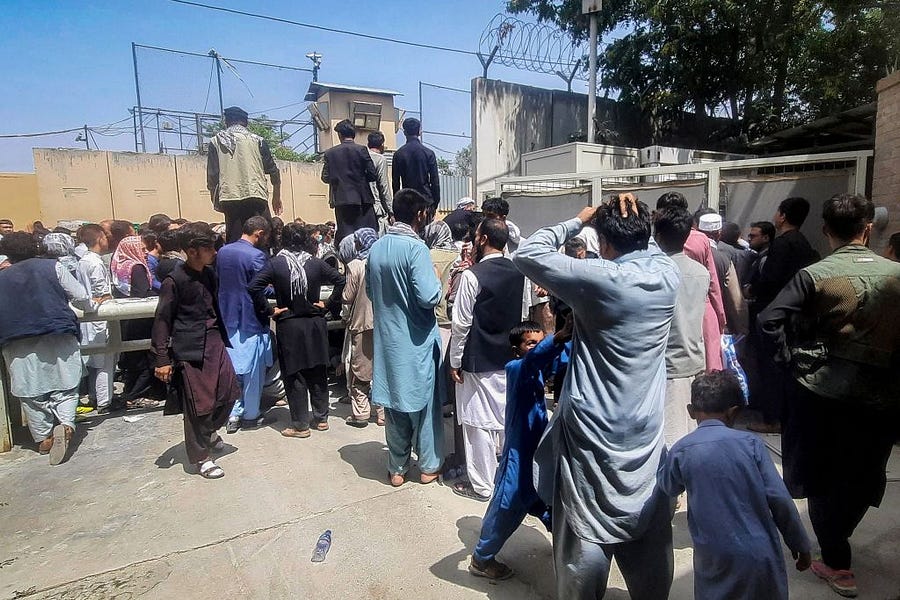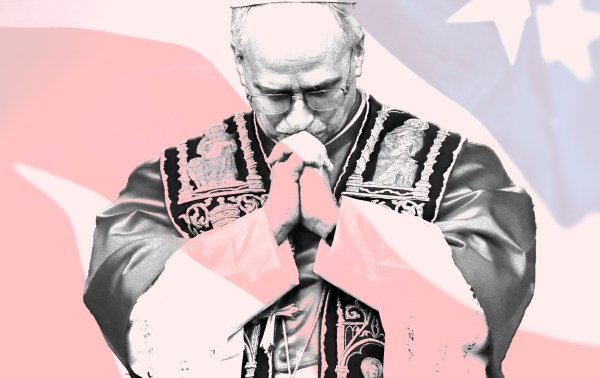As Afghanistan falls into the hands of the Taliban, a refugee crisis is all but inevitable. While focus so far has been on evacuating interpreters and other locals who have worked for the United States and its allies, the reality is that we should expect a massive exodus of Afghans in the near future. During the height of the Syrian civil war from 2011 to 2017, nearly one quarter of Syria’s population left. If the same ratio repeats in Afghanistan, that would mean about 10 million refugees.
There is one key difference this time: For the past several decades, Europe has taken in most refugees fleeing trouble spots. Not just Syria, but those fleeing Afghanistan, Iraq, and Libya. In 2007, the Swedish city of Södertälje (population 100,000) welcomed more Iraqi refugees than the entire United States and Canada combined. The rise of ISIS led to the largest wave of refugees into Europe since World War II. The political environment in Europe has changed dramatically in recent years, however, and no government with any sense of political self-preservation would allow the kind of mass immigration seen in 2015. Politics aside, the economic situation simply would not allow a repeat of 2015, as Western European countries are still struggling to assimilate those who have come here during the last two decades, and the ongoing costs of caring for them has put a serious strain on our social safety nets. America will have to clean up its own mess this time.
As a European with experience of working with economic and migration policy, and who witnessed what happened in my home country of Sweden, I have seen what works—and especially what doesn’t.
The United States needs to set up “safe zones.” Ideally, these safe zones should have been inside Afghanistan, but it’s too late for that now. Hence, they need to be located in nearby regions. Massive refugee camps, complete with the infrastructure necessary to facilitate long term accommodation, will be necessary since refugees will not be able to leave any time soon: Water treatment plants, makeshift hospitals, schools, law enforcement to keep the peace within the camps (refugees will come from many different—and often rival—tribes), and of course military. And the safe zones will need protection too, from either the Taliban or from local gangs and militias, depending on where they are located. These safe zones will have to be somewhat close to and accessible from Afghanistan, as refugees need to be able to reach them by land (airlifts are unlikely to be an option for most of them).
The camps will also require one important element of human infrastructure: interpreters. Since relatively few Afghans speak English, the American staff (humanitarian and military) maintaining the safe zones will need to have interpreters with them to effectively carry out their jobs. This challenge will be even greater considering that the U.S. has been disastrously slow in processing visas for the interpreters who have been helping us in Afghanistan. Even if that problem can be solved, who’s to say how many interpreters will be willing to work in such camps?
That being said, the U.S. does also have a moral obligation to accept refugees, which means increasing the refugee cap. In 1980, after the Iranian revolution, the U.S. refugee cap was 231,700. In 2016, Barack Obama’s last year in office, it was 85,000. Donald Trump dropped it drastically, to 18,000 in 2020. The refugee cap was raised earlier this year, to 62,500, and will almost certainly be raised further as the administration struggles to save face after the Saigon-like withdrawal. With that in mind, here are some lessons you can take from Europe:
Not everyone who flees the Taliban will hold western values. One mistake Europe made was to assume that people fleeing oppressive Islamic regimes would not hold values similar to those regimes. The truth is, people flee for all kinds of reasons: Some will be escaping Afghanistan because they adhere to the principles of western liberal democracy. Others will leave because their homes have been destroyed. Others, because they anticipate that their country is about to become a lot poorer with the Taliban in charge and opportunities are looking better elsewhere. While the Taliban does not have and likely never had majority support, 99 percent of Afghans agreed in a 2011 Pew Research survey that sharia should be the official law of their country, with 78 percent agreeing that religious judges should have the right to decide family and property disputes. It’s not looking much better on the topic of women’s rights: Only 30 percent of Afghans said in a 2013 poll that women should get to decide whether to wear a veil, and 94 percent said a woman must always obey her husband.
Perhaps most problematic are the 79 percent who believe that those who leave Islam deserve the death penalty. This has become a major issue in Europe, with former Muslims being harassed, violently assaulted and even killed by their former coreligionists. Furthermore, 60 percent agree that honor killings of women are sometimes or often justified when a woman has engaged in pre-marital or extra-marital sex (only 24 percent say honor killings are never justified).
While it is likely that the relatively liberal minority in Afghanistan will be somewhat overrepresented among asylum seekers, there are still millions of people who would prefer living in the U.S. to living in Afghanistan not because they ideologically oppose the Taliban, but because the standard of living in the U.S. is drastically higher regardless of who is in charge of Afghanistan. For this reason, refugees need to be vetted to whatever extent possible. Well-meaning proponents of welcoming refugees point to the successful assimilation of South Vietnamese refugees who arrived to the U.S. after the fall of Saigon. This, however, ignores how much closer South Vietnam was to the U.S. culturally compared with Afghanistan. As these numbers should make clear, assimilating Afghans into U.S. society will be a much more difficult challenge.
Refugees need to be distributed evenly. The single greatest error of Swedish migration policy was the use of certain cities and areas as “dumping grounds” for refugees. In our third biggest city, Malmö, a third of the population was foreign-born by the end of 2018, an increase of 40 percent since 2002. In certain areas of Stockholm, Gothenburg, and Malmö, immigrants make up 80-90 percent of the population.
The effects have been disastrous. With few Swedes around to talk to, immigrants do not feel the need to learn Swedish, and even if they want to, they face few real-world situations where they can practice. Since knowledge of the Swedish language is a prerequisite for almost every job in Sweden, unemployment rates are extremely high among refugees. Further, this kind of segregation also means that immigrants fail to assimilate and adapt the norms of Swedish society, instead falling back on the rules and traditions they grew up with. The consequences are particularly dire for women.
To avoid these kinds of “refugee clusters” from forming, the federal government needs to ensure that states accept refugees roughly in proportion to their population. States should also ideally distribute refugees as evenly as possible among their towns and cities. This ensures that refugees are immersed into the American culture and way of life, rather than a few American cities suddenly finding themselves immersed into the Afghan way of life (as happened to Malmö and several other Swedish cities).
Women and children first. Women and children are the most vulnerable Afghan citizens, and for that reason alone they deserve to be prioritized for relocation to the United States. But as we discovered in Europe, there is another important reason to prioritize female asylum seekers.
The vast majority of asylum seekers are men. During the last refugee crisis in 2015, 73 percent of those who sought asylum in the EU were men, and 51 percent were men below the age of 35. Turning our focus specifically to Afghanistan, 81 percent of asylum seekers were men, and 76 percent men under the age of 35. There are several reasons for this, most importantly perhaps that travelling to Europe from the Middle East is an expensive and treacherous journey. What few in Europe had the foresight to understand was that such a heavy gender imbalance would mean that a lot of young men would find it difficult to fulfill the social expectation of marrying within their own group. This kind of “women shortage” is associated with highly destructive behavior.
As of right now, only about 156,000 Afghans live in America (this number includes children of immigrants). That number could very well double or triple within the next few years. Without an appropriate gender ratio (with more women being better than more men) among the newcomers, this could spell serious trouble for the Afghan-American community.
Set realistic expectations. One of the greatest lies sold by the political establishment in Europe was that the asylum seekers would eventually “turn a profit”: Sure, the state would have to spend a lot initially to help them get settled into society, but then once they began to pay taxes it would all be fine. In fact, politicians argued with a straight face that we needed the influx of asylum seekers to save our welfare states.
While there is a humanitarian argument to be made for welcoming refugees, there is no such profitability argument. The cost of resettling refugees is enormous, all of them will be relying on social safety nets for several years, and when they do get jobs, they are likely to be low-paid and thus not generate all that much in terms of tax revenue. Refugees also commit a disproportionate number of crimes, especially violent and sexual crimes, due to a mixture of culture and the result of the trauma they have experienced. The U.S. needs to make it clear to all those granted asylum that, while they no doubt have experienced unimaginable horrors, they are still expected to obey US laws, even those which they may disagree with or struggle to understand. Further, many will need serious mental health support to deal with PTSD and similar disorders. This, again, will have to be paid for by taxpayers.
Many Afghan refugees will lack a sufficient education, or not have educational credentials that can be verified or translated to an American equivalent. Providing education will be another great taxpayer expense.
Like the war in Afghanistan, this humanitarian project will almost certainly turn out to be a multi-decade commitment, as refugees will be unable to return as long as the Taliban rule remains. The U,S. has a moral obligation to help these, but American politicians should be careful not to attempt to trick its people into thinking it is making an investment, when it is in fact engaging in an act of charity.






Please note that we at The Dispatch hold ourselves, our work, and our commenters to a higher standard than other places on the internet. We welcome comments that foster genuine debate or discussion—including comments critical of us or our work—but responses that include ad hominem attacks on fellow Dispatch members or are intended to stoke fear and anger may be moderated.
With your membership, you only have the ability to comment on The Morning Dispatch articles. Consider upgrading to join the conversation everywhere.